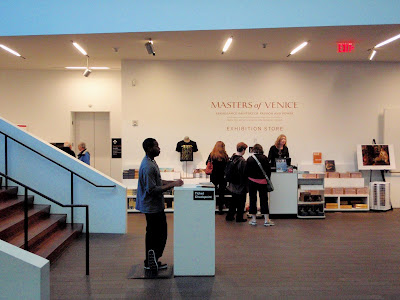
Back before they rebuilt the DeYoung Museum but after they realized they needed to, there was some talk about relocating the museum from Golden Gate Park downtown, closer to other museums like the Museum of Modern Art, the Jewish Contemporary Museum, the Cartoon Art Museum, and the Museum of the African Diaspora, where it would be more accessible to the rest of the Bay Area and help form sort of a "museum district." I thought this was a great idea, but nothing came of it (oh, the unseen backstage intrigues that shape our existences!), and the DeYoung remains a long trek out of the way for most Bay Area residents.

I’ve never regretted the museum’s location more than during its magnificent current show, Masters of Venice: Renaissance Painters of Passion and Power, a jaw-dropping assortment of Mantegnas, Giorgiones, Titians, Tintorettos, and Veroneses (along with assorted others) on loan from the Kunsthistorisches Museum in Vienna. If the DeYoung were as accessible as SFMoMA, I’d be visiting this collection once or twice a week, the way I did with the Stein collection this summer. If you have any interest in Italian Renaissance painting, Venetian art, Old Masters, pictures of pretty naked people, or just great art in general, you really need to see this show. I’m hoping to go back again before it closes February 12.

On my first visit I was in the gift shop buying the very attractive and inexpensive catalogue and some prints and postcards, and a young saleswoman proudly pointed out that the DeYoung is the only venue for this show. I asked why that was. She told me that the galleries in Vienna were being redone. I already knew that, so I explained that what I meant was Why here? I didn’t want to come right out and say, “Why here, instead of a more prestigious venue like the Metropolitan or the National Gallery?” She didn’t know why. Another of those unseen backstage intrigues, I guess.
Whatever the reason, I’m grateful. It’s hard to describe how stunned and excited I was to turn a corner and see, in all its glorious jeweler’s precision, Mantegna’s St Sebastian, something I’ve known in reproduction most of my life. And here was the actual, irreplaceable thing! (Also: I don’t usually associate Mantegna with Venetian art, though he was active in Padua, which is close to Venice and was part of the Venetian republic at that time. But he comes down pretty clearly on the side of line as form rather than color as form, which is what the Venetian painters were famous for (to put it in terms of their contemporary art theory, he favored disegno over colore).)

And then to turn another corner and come across the enigmatic poetry of Giorgione, with his melting lucid landscapes and the calmly assertive looks of his many-meaninged figures, then to the bold Titians with their glowing nude women (and his later canvases, where the increasingly vivid brushwork almost takes over as the subject of the picture, in the modern way), and then to the Mannerist elongations of Palma Vecchio’s Bathing Nymphs, and the lambent rows of what a wall label amusingly and accurately describes as “beautiful anonymous blonde women,” and then to the vivid Tintorettos and the lush Veroneses . . . the DeYoung has become, temporarily at least, one of the great museums.

There are a few interesting labels discussing the changes due to the use of oil paints from tempera (richer, thicker colors) and canvas rather than wood (a different surface texture). Frescoes were less significant in Venice as well, due to the general dampness of the climate, which is nice for us since panels can travel and frescoes can’t (though frankly I can’t believe some of these paintings were available for loan – the St Sebastian, Giorgione’s Three Philosophers, Titian’s Danae – these, and others in the show, are some of the great images of Renaissance art).

Some of the assertions on the wall labels seem dubious, like the one about Tintoretto’s Susanna and the Elders (I’m quoting the version in the catalogue): “Men often displayed paintings of this kind in bedrooms, to remind their wives about proper married behavior.” Really? Susanna was a virtuous young wife, spied upon in her bath by two lecherous old men, pillars of the community. In an early example of sexual harassment, they threatened to claim she was an adulteress unless she actually became one with them. She refused and they accused. She was about to be stoned to death based on their calumnies when the prophet Daniel, then a boy, rose up and insisted on questioning the two old men separately (CSI: Ancient Israel!). Their contradictory answers exposed their falsehood, and the crowd stoned them to death, instead of the virtuous Susanna. If you know this story, and I assume any Renaissance Venetian who would own a Tintoretto would, it seems a lot more like a warning about proper married behavior for husbands. Tintoretto’s lushly decorative version may lack the psychological intensity of Artemisia Gentileschi’s versions, but it’s perfectly clear that his naked woman is pure of heart and his crouching old voyeurs are not.

I can only hope that some day the Kunsthistorisches Museum decides to redo their Pieter Brueghel galleries, with the Bay Area once again the beneficiary. If that happened I really would trek out to the DeYoung once or twice a week, no matter how awful the bus rides.
No comments:
Post a Comment